Critical Thinking for Managers - PDF
VerifiedAdded on 2021/05/31
|12
|3189
|105
AI Summary
Contribute Materials
Your contribution can guide someone’s learning journey. Share your
documents today.
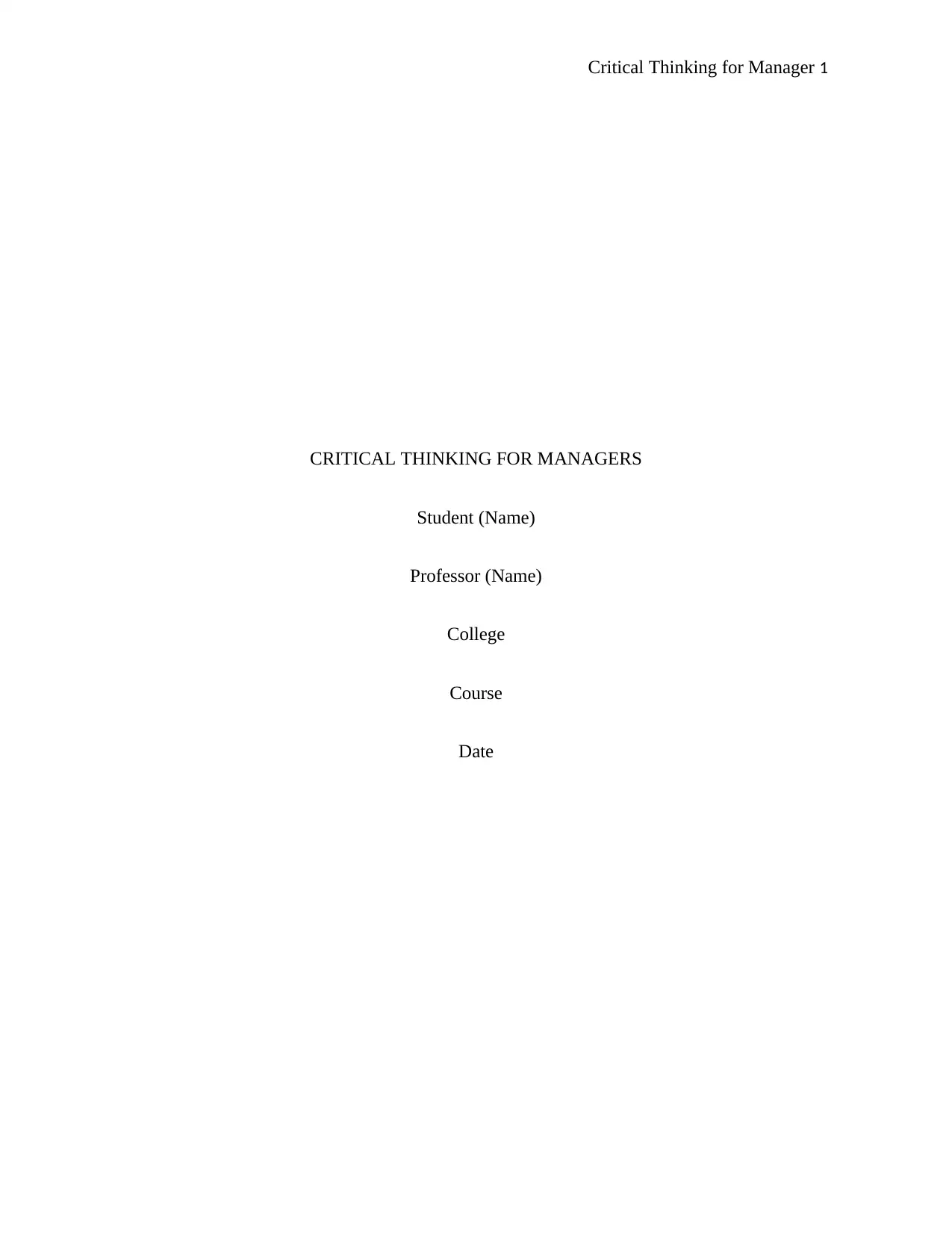
Critical Thinking for Manager 1
CRITICAL THINKING FOR MANAGERS
Student (Name)
Professor (Name)
College
Course
Date
CRITICAL THINKING FOR MANAGERS
Student (Name)
Professor (Name)
College
Course
Date
Secure Best Marks with AI Grader
Need help grading? Try our AI Grader for instant feedback on your assignments.
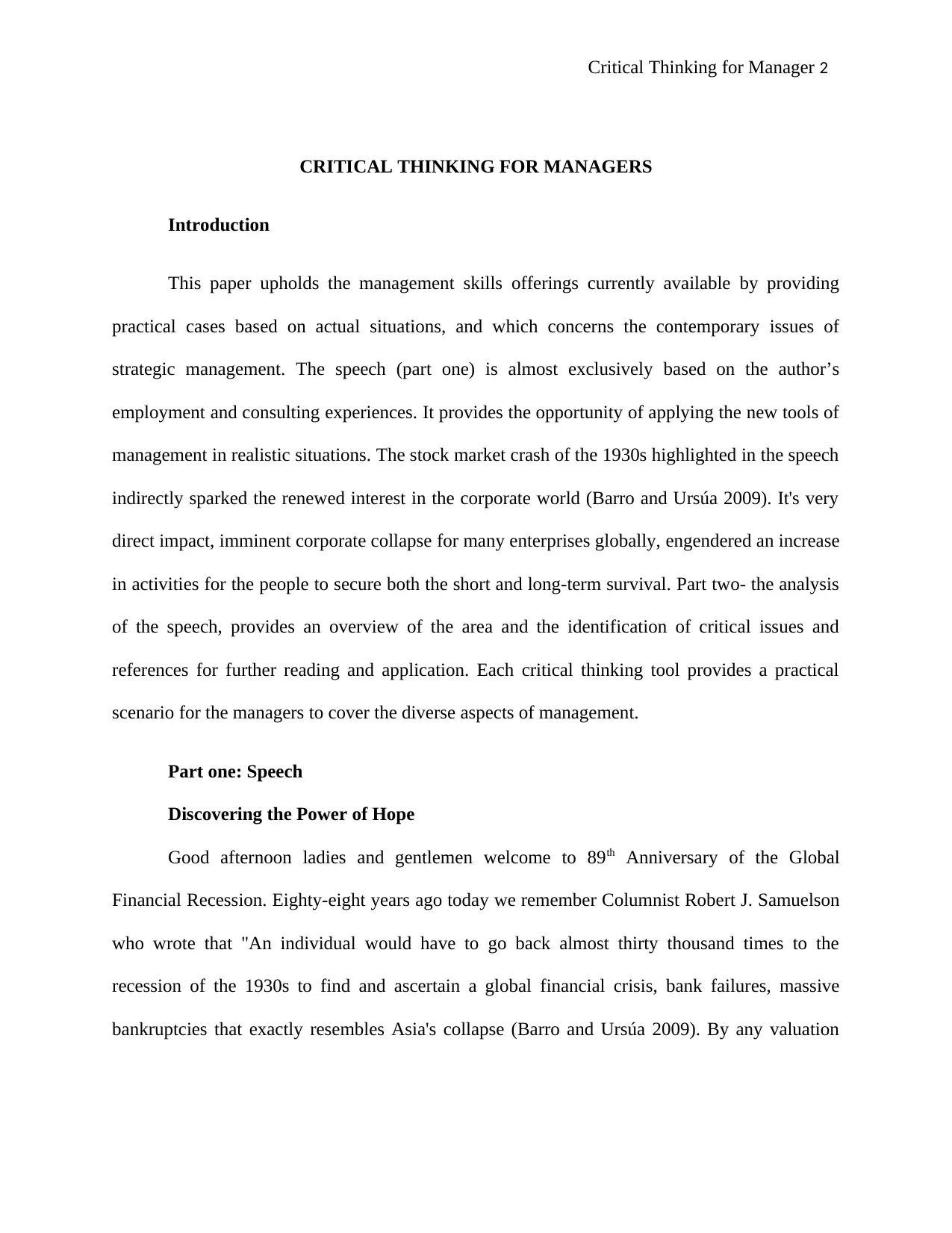
Critical Thinking for Manager 2
CRITICAL THINKING FOR MANAGERS
Introduction
This paper upholds the management skills offerings currently available by providing
practical cases based on actual situations, and which concerns the contemporary issues of
strategic management. The speech (part one) is almost exclusively based on the author’s
employment and consulting experiences. It provides the opportunity of applying the new tools of
management in realistic situations. The stock market crash of the 1930s highlighted in the speech
indirectly sparked the renewed interest in the corporate world (Barro and Ursúa 2009). It's very
direct impact, imminent corporate collapse for many enterprises globally, engendered an increase
in activities for the people to secure both the short and long-term survival. Part two- the analysis
of the speech, provides an overview of the area and the identification of critical issues and
references for further reading and application. Each critical thinking tool provides a practical
scenario for the managers to cover the diverse aspects of management.
Part one: Speech
Discovering the Power of Hope
Good afternoon ladies and gentlemen welcome to 89th Anniversary of the Global
Financial Recession. Eighty-eight years ago today we remember Columnist Robert J. Samuelson
who wrote that "An individual would have to go back almost thirty thousand times to the
recession of the 1930s to find and ascertain a global financial crisis, bank failures, massive
bankruptcies that exactly resembles Asia's collapse (Barro and Ursúa 2009). By any valuation
CRITICAL THINKING FOR MANAGERS
Introduction
This paper upholds the management skills offerings currently available by providing
practical cases based on actual situations, and which concerns the contemporary issues of
strategic management. The speech (part one) is almost exclusively based on the author’s
employment and consulting experiences. It provides the opportunity of applying the new tools of
management in realistic situations. The stock market crash of the 1930s highlighted in the speech
indirectly sparked the renewed interest in the corporate world (Barro and Ursúa 2009). It's very
direct impact, imminent corporate collapse for many enterprises globally, engendered an increase
in activities for the people to secure both the short and long-term survival. Part two- the analysis
of the speech, provides an overview of the area and the identification of critical issues and
references for further reading and application. Each critical thinking tool provides a practical
scenario for the managers to cover the diverse aspects of management.
Part one: Speech
Discovering the Power of Hope
Good afternoon ladies and gentlemen welcome to 89th Anniversary of the Global
Financial Recession. Eighty-eight years ago today we remember Columnist Robert J. Samuelson
who wrote that "An individual would have to go back almost thirty thousand times to the
recession of the 1930s to find and ascertain a global financial crisis, bank failures, massive
bankruptcies that exactly resembles Asia's collapse (Barro and Ursúa 2009). By any valuation
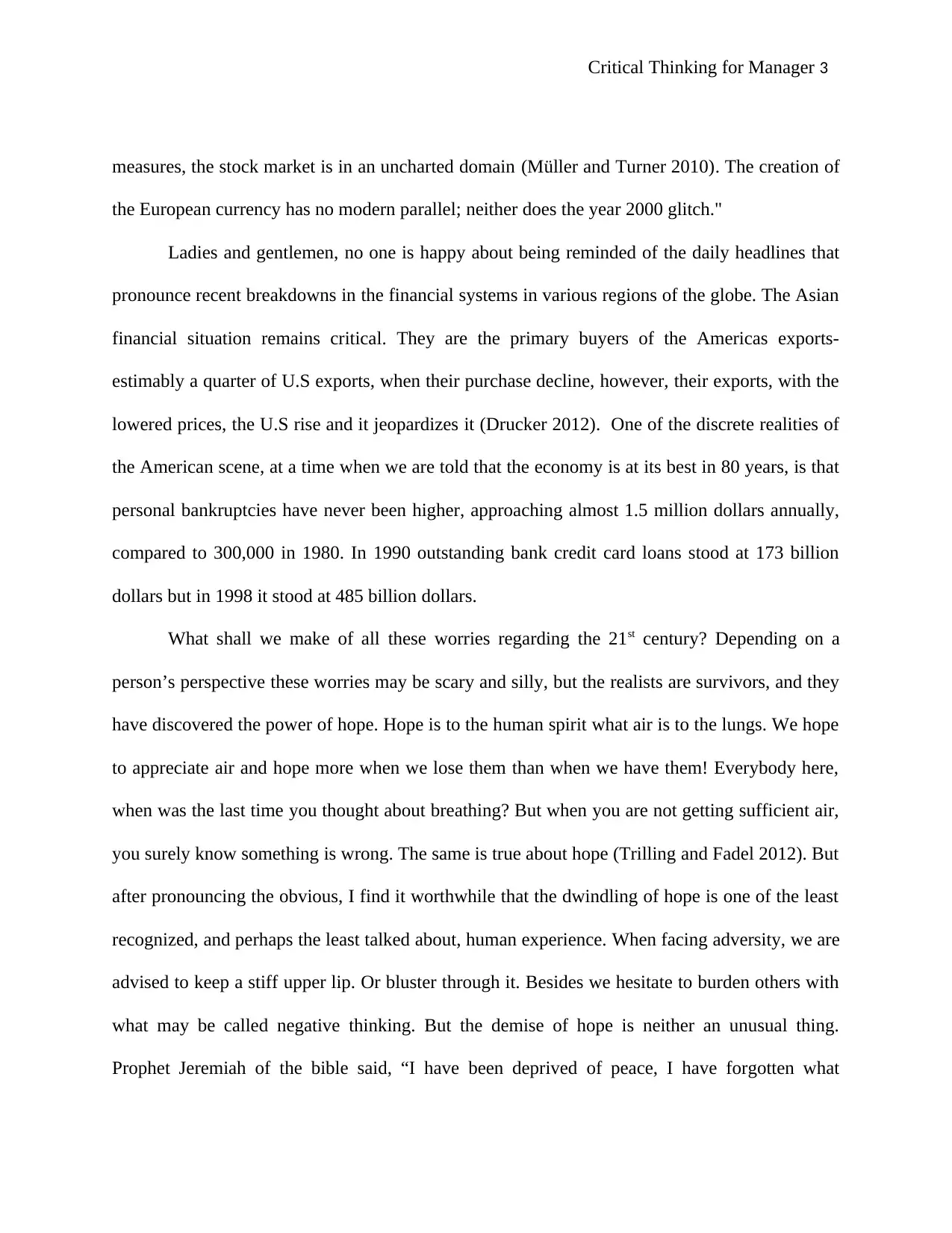
Critical Thinking for Manager 3
measures, the stock market is in an uncharted domain (Müller and Turner 2010). The creation of
the European currency has no modern parallel; neither does the year 2000 glitch."
Ladies and gentlemen, no one is happy about being reminded of the daily headlines that
pronounce recent breakdowns in the financial systems in various regions of the globe. The Asian
financial situation remains critical. They are the primary buyers of the Americas exports-
estimably a quarter of U.S exports, when their purchase decline, however, their exports, with the
lowered prices, the U.S rise and it jeopardizes it (Drucker 2012). One of the discrete realities of
the American scene, at a time when we are told that the economy is at its best in 80 years, is that
personal bankruptcies have never been higher, approaching almost 1.5 million dollars annually,
compared to 300,000 in 1980. In 1990 outstanding bank credit card loans stood at 173 billion
dollars but in 1998 it stood at 485 billion dollars.
What shall we make of all these worries regarding the 21st century? Depending on a
person’s perspective these worries may be scary and silly, but the realists are survivors, and they
have discovered the power of hope. Hope is to the human spirit what air is to the lungs. We hope
to appreciate air and hope more when we lose them than when we have them! Everybody here,
when was the last time you thought about breathing? But when you are not getting sufficient air,
you surely know something is wrong. The same is true about hope (Trilling and Fadel 2012). But
after pronouncing the obvious, I find it worthwhile that the dwindling of hope is one of the least
recognized, and perhaps the least talked about, human experience. When facing adversity, we are
advised to keep a stiff upper lip. Or bluster through it. Besides we hesitate to burden others with
what may be called negative thinking. But the demise of hope is neither an unusual thing.
Prophet Jeremiah of the bible said, “I have been deprived of peace, I have forgotten what
measures, the stock market is in an uncharted domain (Müller and Turner 2010). The creation of
the European currency has no modern parallel; neither does the year 2000 glitch."
Ladies and gentlemen, no one is happy about being reminded of the daily headlines that
pronounce recent breakdowns in the financial systems in various regions of the globe. The Asian
financial situation remains critical. They are the primary buyers of the Americas exports-
estimably a quarter of U.S exports, when their purchase decline, however, their exports, with the
lowered prices, the U.S rise and it jeopardizes it (Drucker 2012). One of the discrete realities of
the American scene, at a time when we are told that the economy is at its best in 80 years, is that
personal bankruptcies have never been higher, approaching almost 1.5 million dollars annually,
compared to 300,000 in 1980. In 1990 outstanding bank credit card loans stood at 173 billion
dollars but in 1998 it stood at 485 billion dollars.
What shall we make of all these worries regarding the 21st century? Depending on a
person’s perspective these worries may be scary and silly, but the realists are survivors, and they
have discovered the power of hope. Hope is to the human spirit what air is to the lungs. We hope
to appreciate air and hope more when we lose them than when we have them! Everybody here,
when was the last time you thought about breathing? But when you are not getting sufficient air,
you surely know something is wrong. The same is true about hope (Trilling and Fadel 2012). But
after pronouncing the obvious, I find it worthwhile that the dwindling of hope is one of the least
recognized, and perhaps the least talked about, human experience. When facing adversity, we are
advised to keep a stiff upper lip. Or bluster through it. Besides we hesitate to burden others with
what may be called negative thinking. But the demise of hope is neither an unusual thing.
Prophet Jeremiah of the bible said, “I have been deprived of peace, I have forgotten what
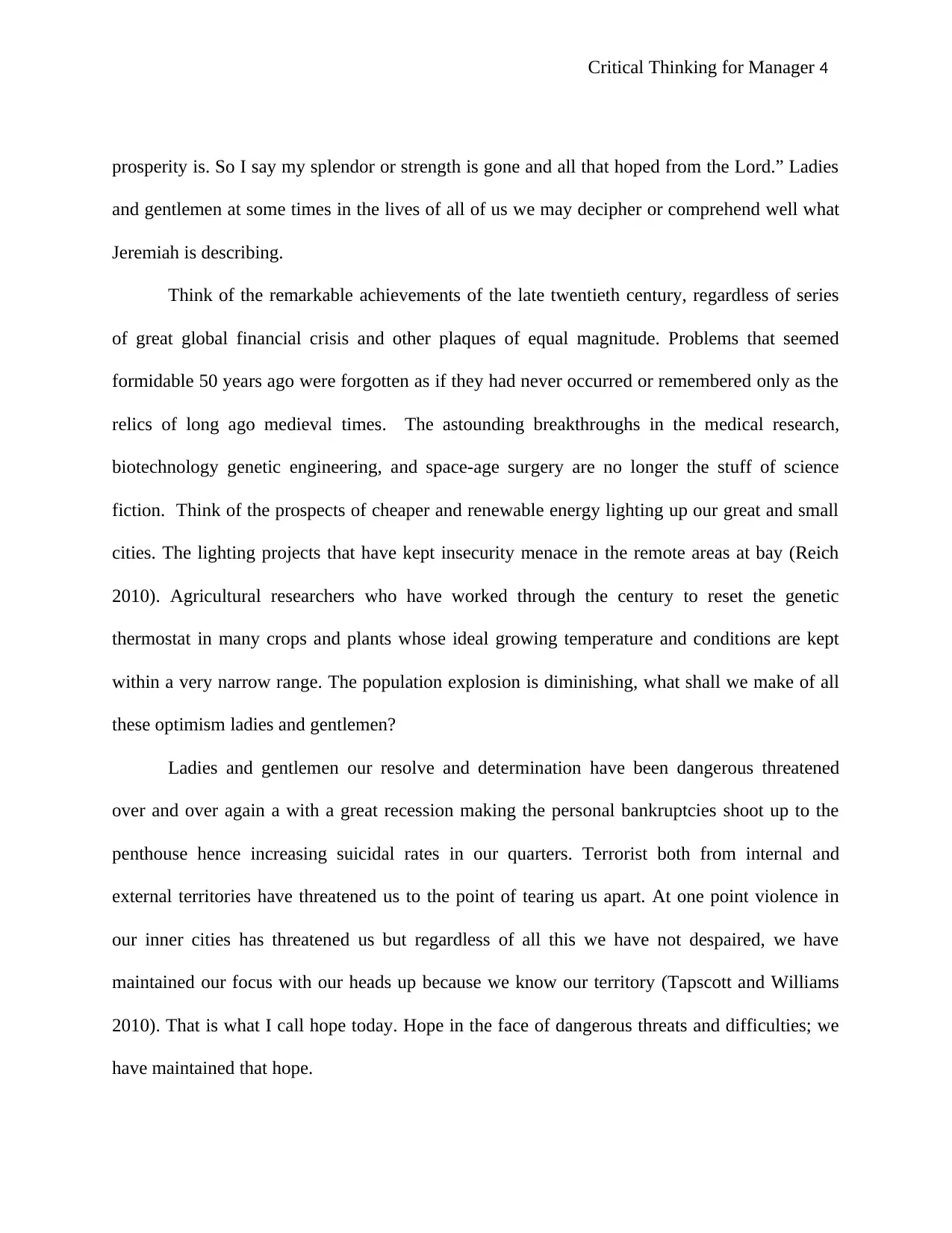
Critical Thinking for Manager 4
prosperity is. So I say my splendor or strength is gone and all that hoped from the Lord.” Ladies
and gentlemen at some times in the lives of all of us we may decipher or comprehend well what
Jeremiah is describing.
Think of the remarkable achievements of the late twentieth century, regardless of series
of great global financial crisis and other plaques of equal magnitude. Problems that seemed
formidable 50 years ago were forgotten as if they had never occurred or remembered only as the
relics of long ago medieval times. The astounding breakthroughs in the medical research,
biotechnology genetic engineering, and space-age surgery are no longer the stuff of science
fiction. Think of the prospects of cheaper and renewable energy lighting up our great and small
cities. The lighting projects that have kept insecurity menace in the remote areas at bay (Reich
2010). Agricultural researchers who have worked through the century to reset the genetic
thermostat in many crops and plants whose ideal growing temperature and conditions are kept
within a very narrow range. The population explosion is diminishing, what shall we make of all
these optimism ladies and gentlemen?
Ladies and gentlemen our resolve and determination have been dangerous threatened
over and over again a with a great recession making the personal bankruptcies shoot up to the
penthouse hence increasing suicidal rates in our quarters. Terrorist both from internal and
external territories have threatened us to the point of tearing us apart. At one point violence in
our inner cities has threatened us but regardless of all this we have not despaired, we have
maintained our focus with our heads up because we know our territory (Tapscott and Williams
2010). That is what I call hope today. Hope in the face of dangerous threats and difficulties; we
have maintained that hope.
prosperity is. So I say my splendor or strength is gone and all that hoped from the Lord.” Ladies
and gentlemen at some times in the lives of all of us we may decipher or comprehend well what
Jeremiah is describing.
Think of the remarkable achievements of the late twentieth century, regardless of series
of great global financial crisis and other plaques of equal magnitude. Problems that seemed
formidable 50 years ago were forgotten as if they had never occurred or remembered only as the
relics of long ago medieval times. The astounding breakthroughs in the medical research,
biotechnology genetic engineering, and space-age surgery are no longer the stuff of science
fiction. Think of the prospects of cheaper and renewable energy lighting up our great and small
cities. The lighting projects that have kept insecurity menace in the remote areas at bay (Reich
2010). Agricultural researchers who have worked through the century to reset the genetic
thermostat in many crops and plants whose ideal growing temperature and conditions are kept
within a very narrow range. The population explosion is diminishing, what shall we make of all
these optimism ladies and gentlemen?
Ladies and gentlemen our resolve and determination have been dangerous threatened
over and over again a with a great recession making the personal bankruptcies shoot up to the
penthouse hence increasing suicidal rates in our quarters. Terrorist both from internal and
external territories have threatened us to the point of tearing us apart. At one point violence in
our inner cities has threatened us but regardless of all this we have not despaired, we have
maintained our focus with our heads up because we know our territory (Tapscott and Williams
2010). That is what I call hope today. Hope in the face of dangerous threats and difficulties; we
have maintained that hope.
Secure Best Marks with AI Grader
Need help grading? Try our AI Grader for instant feedback on your assignments.
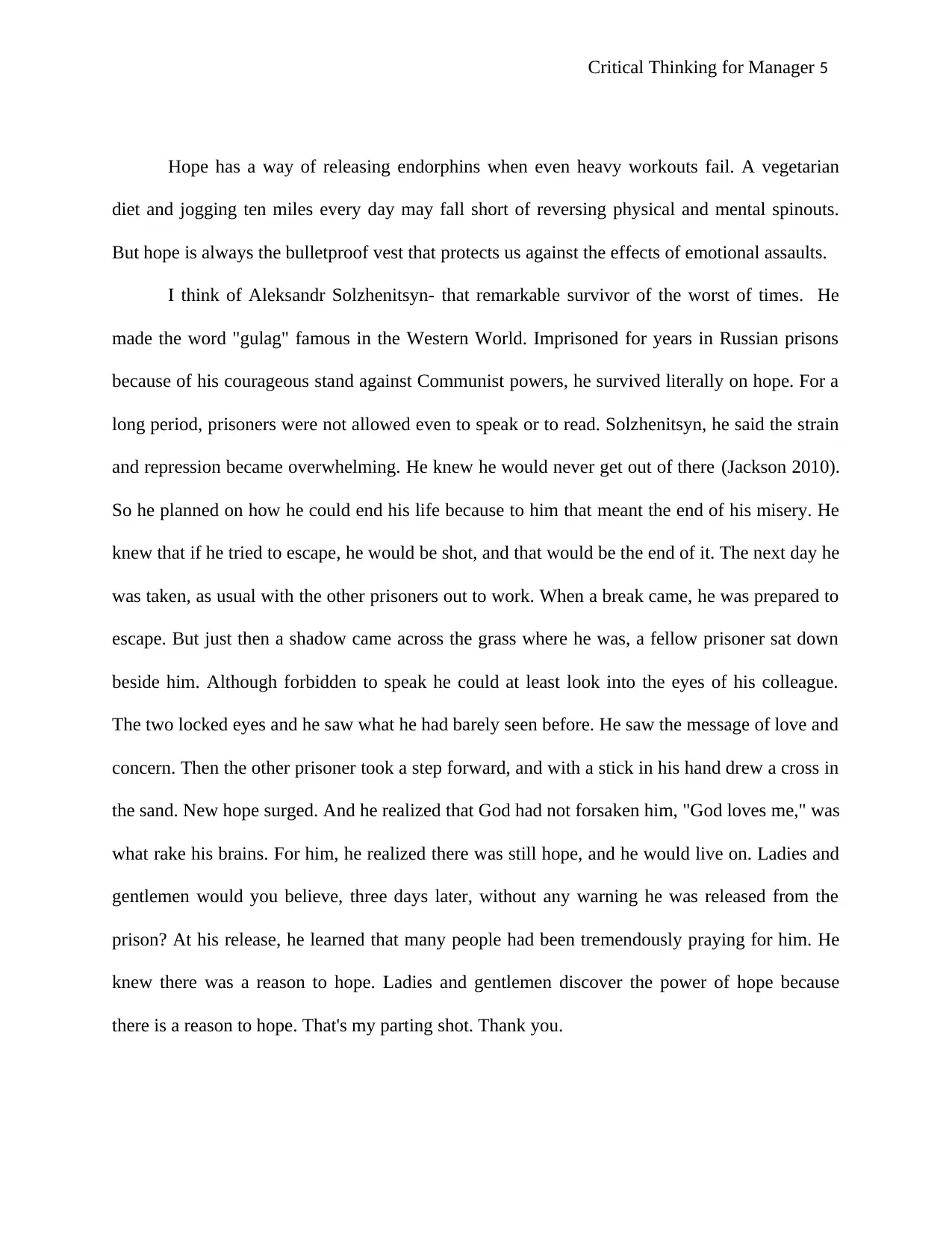
Critical Thinking for Manager 5
Hope has a way of releasing endorphins when even heavy workouts fail. A vegetarian
diet and jogging ten miles every day may fall short of reversing physical and mental spinouts.
But hope is always the bulletproof vest that protects us against the effects of emotional assaults.
I think of Aleksandr Solzhenitsyn- that remarkable survivor of the worst of times. He
made the word "gulag" famous in the Western World. Imprisoned for years in Russian prisons
because of his courageous stand against Communist powers, he survived literally on hope. For a
long period, prisoners were not allowed even to speak or to read. Solzhenitsyn, he said the strain
and repression became overwhelming. He knew he would never get out of there (Jackson 2010).
So he planned on how he could end his life because to him that meant the end of his misery. He
knew that if he tried to escape, he would be shot, and that would be the end of it. The next day he
was taken, as usual with the other prisoners out to work. When a break came, he was prepared to
escape. But just then a shadow came across the grass where he was, a fellow prisoner sat down
beside him. Although forbidden to speak he could at least look into the eyes of his colleague.
The two locked eyes and he saw what he had barely seen before. He saw the message of love and
concern. Then the other prisoner took a step forward, and with a stick in his hand drew a cross in
the sand. New hope surged. And he realized that God had not forsaken him, "God loves me," was
what rake his brains. For him, he realized there was still hope, and he would live on. Ladies and
gentlemen would you believe, three days later, without any warning he was released from the
prison? At his release, he learned that many people had been tremendously praying for him. He
knew there was a reason to hope. Ladies and gentlemen discover the power of hope because
there is a reason to hope. That's my parting shot. Thank you.
Hope has a way of releasing endorphins when even heavy workouts fail. A vegetarian
diet and jogging ten miles every day may fall short of reversing physical and mental spinouts.
But hope is always the bulletproof vest that protects us against the effects of emotional assaults.
I think of Aleksandr Solzhenitsyn- that remarkable survivor of the worst of times. He
made the word "gulag" famous in the Western World. Imprisoned for years in Russian prisons
because of his courageous stand against Communist powers, he survived literally on hope. For a
long period, prisoners were not allowed even to speak or to read. Solzhenitsyn, he said the strain
and repression became overwhelming. He knew he would never get out of there (Jackson 2010).
So he planned on how he could end his life because to him that meant the end of his misery. He
knew that if he tried to escape, he would be shot, and that would be the end of it. The next day he
was taken, as usual with the other prisoners out to work. When a break came, he was prepared to
escape. But just then a shadow came across the grass where he was, a fellow prisoner sat down
beside him. Although forbidden to speak he could at least look into the eyes of his colleague.
The two locked eyes and he saw what he had barely seen before. He saw the message of love and
concern. Then the other prisoner took a step forward, and with a stick in his hand drew a cross in
the sand. New hope surged. And he realized that God had not forsaken him, "God loves me," was
what rake his brains. For him, he realized there was still hope, and he would live on. Ladies and
gentlemen would you believe, three days later, without any warning he was released from the
prison? At his release, he learned that many people had been tremendously praying for him. He
knew there was a reason to hope. Ladies and gentlemen discover the power of hope because
there is a reason to hope. That's my parting shot. Thank you.
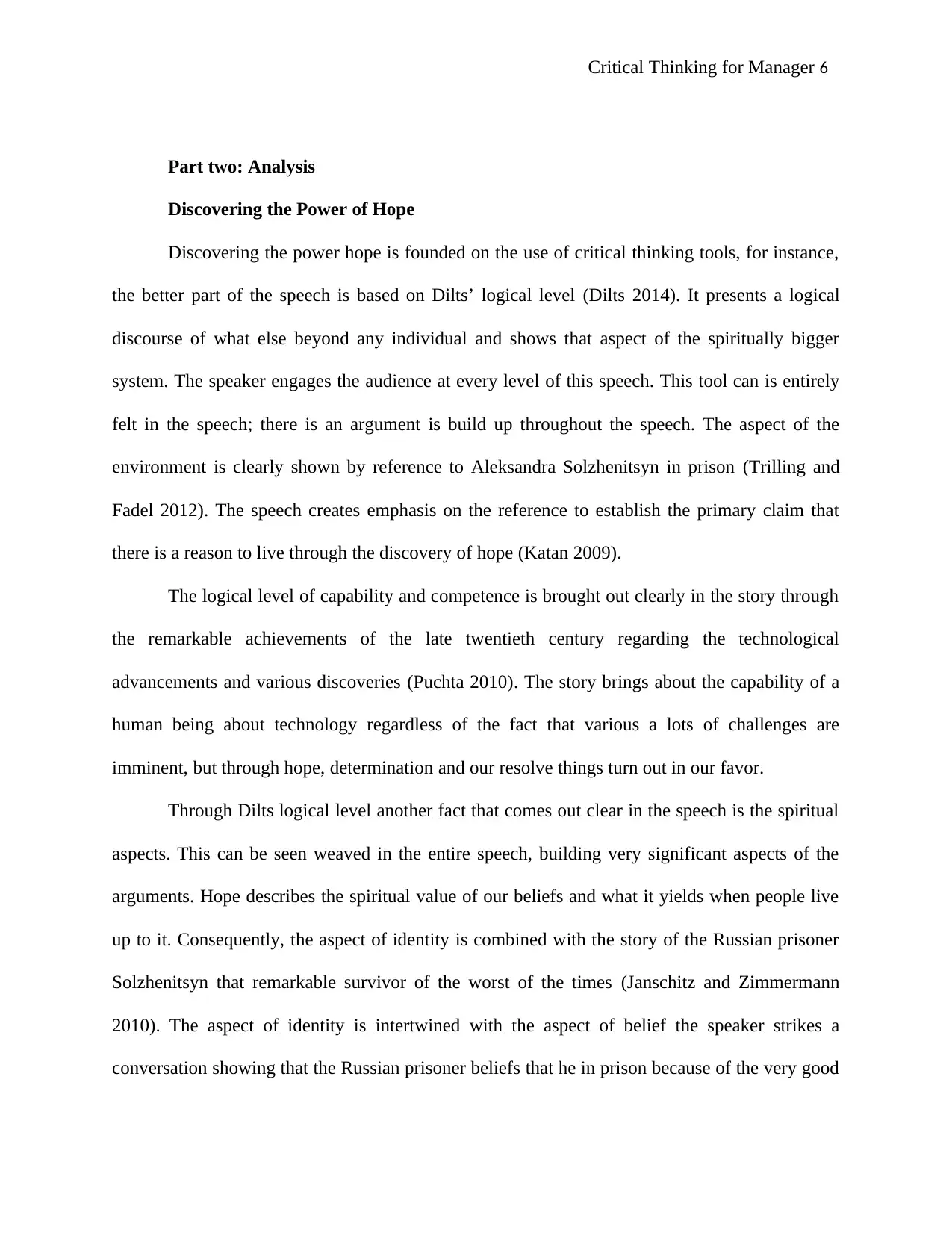
Critical Thinking for Manager 6
Part two: Analysis
Discovering the Power of Hope
Discovering the power hope is founded on the use of critical thinking tools, for instance,
the better part of the speech is based on Dilts’ logical level (Dilts 2014). It presents a logical
discourse of what else beyond any individual and shows that aspect of the spiritually bigger
system. The speaker engages the audience at every level of this speech. This tool can is entirely
felt in the speech; there is an argument is build up throughout the speech. The aspect of the
environment is clearly shown by reference to Aleksandra Solzhenitsyn in prison (Trilling and
Fadel 2012). The speech creates emphasis on the reference to establish the primary claim that
there is a reason to live through the discovery of hope (Katan 2009).
The logical level of capability and competence is brought out clearly in the story through
the remarkable achievements of the late twentieth century regarding the technological
advancements and various discoveries (Puchta 2010). The story brings about the capability of a
human being about technology regardless of the fact that various a lots of challenges are
imminent, but through hope, determination and our resolve things turn out in our favor.
Through Dilts logical level another fact that comes out clear in the speech is the spiritual
aspects. This can be seen weaved in the entire speech, building very significant aspects of the
arguments. Hope describes the spiritual value of our beliefs and what it yields when people live
up to it. Consequently, the aspect of identity is combined with the story of the Russian prisoner
Solzhenitsyn that remarkable survivor of the worst of the times (Janschitz and Zimmermann
2010). The aspect of identity is intertwined with the aspect of belief the speaker strikes a
conversation showing that the Russian prisoner beliefs that he in prison because of the very good
Part two: Analysis
Discovering the Power of Hope
Discovering the power hope is founded on the use of critical thinking tools, for instance,
the better part of the speech is based on Dilts’ logical level (Dilts 2014). It presents a logical
discourse of what else beyond any individual and shows that aspect of the spiritually bigger
system. The speaker engages the audience at every level of this speech. This tool can is entirely
felt in the speech; there is an argument is build up throughout the speech. The aspect of the
environment is clearly shown by reference to Aleksandra Solzhenitsyn in prison (Trilling and
Fadel 2012). The speech creates emphasis on the reference to establish the primary claim that
there is a reason to live through the discovery of hope (Katan 2009).
The logical level of capability and competence is brought out clearly in the story through
the remarkable achievements of the late twentieth century regarding the technological
advancements and various discoveries (Puchta 2010). The story brings about the capability of a
human being about technology regardless of the fact that various a lots of challenges are
imminent, but through hope, determination and our resolve things turn out in our favor.
Through Dilts logical level another fact that comes out clear in the speech is the spiritual
aspects. This can be seen weaved in the entire speech, building very significant aspects of the
arguments. Hope describes the spiritual value of our beliefs and what it yields when people live
up to it. Consequently, the aspect of identity is combined with the story of the Russian prisoner
Solzhenitsyn that remarkable survivor of the worst of the times (Janschitz and Zimmermann
2010). The aspect of identity is intertwined with the aspect of belief the speaker strikes a
conversation showing that the Russian prisoner beliefs that he in prison because of the very good
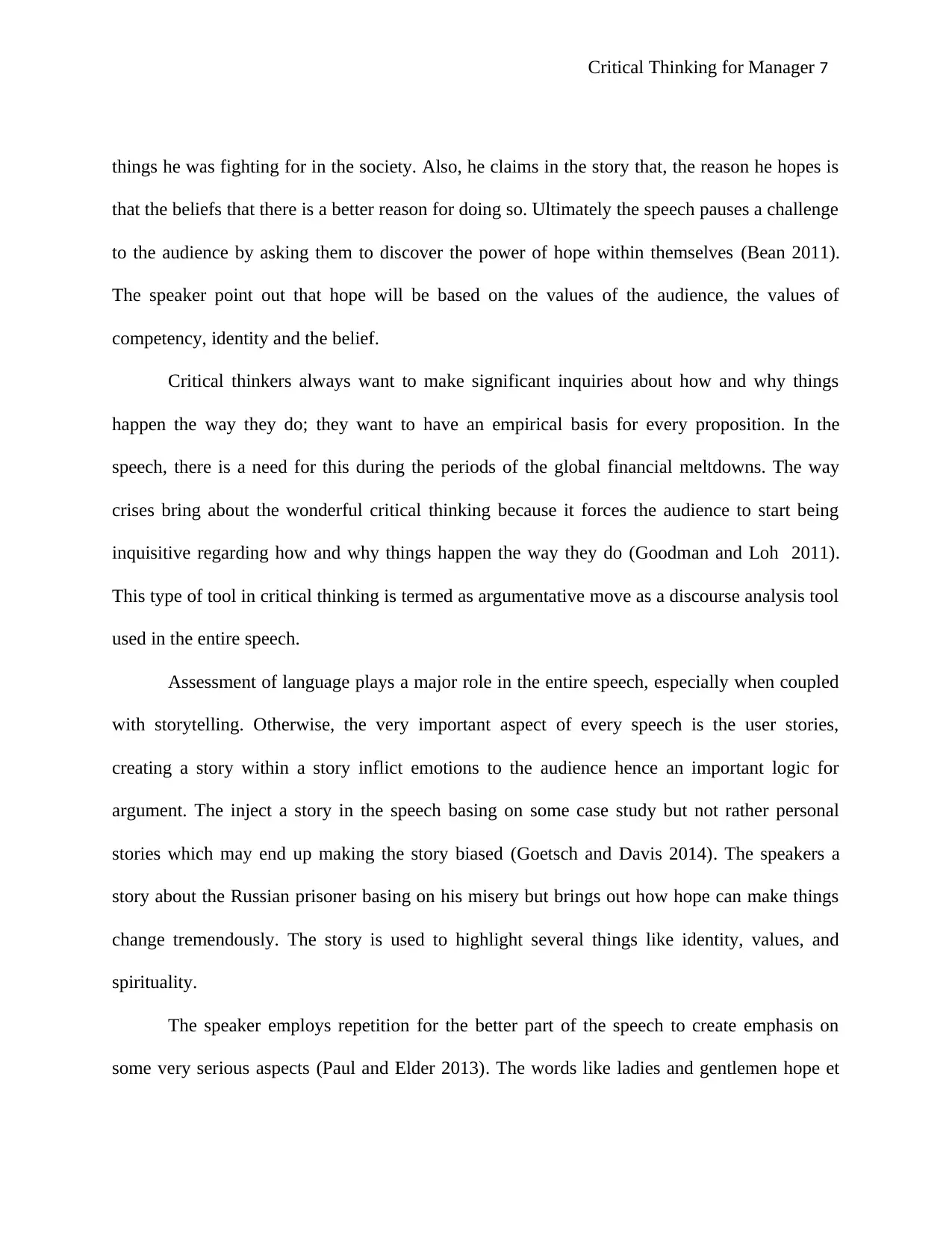
Critical Thinking for Manager 7
things he was fighting for in the society. Also, he claims in the story that, the reason he hopes is
that the beliefs that there is a better reason for doing so. Ultimately the speech pauses a challenge
to the audience by asking them to discover the power of hope within themselves (Bean 2011).
The speaker point out that hope will be based on the values of the audience, the values of
competency, identity and the belief.
Critical thinkers always want to make significant inquiries about how and why things
happen the way they do; they want to have an empirical basis for every proposition. In the
speech, there is a need for this during the periods of the global financial meltdowns. The way
crises bring about the wonderful critical thinking because it forces the audience to start being
inquisitive regarding how and why things happen the way they do (Goodman and Loh 2011).
This type of tool in critical thinking is termed as argumentative move as a discourse analysis tool
used in the entire speech.
Assessment of language plays a major role in the entire speech, especially when coupled
with storytelling. Otherwise, the very important aspect of every speech is the user stories,
creating a story within a story inflict emotions to the audience hence an important logic for
argument. The inject a story in the speech basing on some case study but not rather personal
stories which may end up making the story biased (Goetsch and Davis 2014). The speakers a
story about the Russian prisoner basing on his misery but brings out how hope can make things
change tremendously. The story is used to highlight several things like identity, values, and
spirituality.
The speaker employs repetition for the better part of the speech to create emphasis on
some very serious aspects (Paul and Elder 2013). The words like ladies and gentlemen hope et
things he was fighting for in the society. Also, he claims in the story that, the reason he hopes is
that the beliefs that there is a better reason for doing so. Ultimately the speech pauses a challenge
to the audience by asking them to discover the power of hope within themselves (Bean 2011).
The speaker point out that hope will be based on the values of the audience, the values of
competency, identity and the belief.
Critical thinkers always want to make significant inquiries about how and why things
happen the way they do; they want to have an empirical basis for every proposition. In the
speech, there is a need for this during the periods of the global financial meltdowns. The way
crises bring about the wonderful critical thinking because it forces the audience to start being
inquisitive regarding how and why things happen the way they do (Goodman and Loh 2011).
This type of tool in critical thinking is termed as argumentative move as a discourse analysis tool
used in the entire speech.
Assessment of language plays a major role in the entire speech, especially when coupled
with storytelling. Otherwise, the very important aspect of every speech is the user stories,
creating a story within a story inflict emotions to the audience hence an important logic for
argument. The inject a story in the speech basing on some case study but not rather personal
stories which may end up making the story biased (Goetsch and Davis 2014). The speakers a
story about the Russian prisoner basing on his misery but brings out how hope can make things
change tremendously. The story is used to highlight several things like identity, values, and
spirituality.
The speaker employs repetition for the better part of the speech to create emphasis on
some very serious aspects (Paul and Elder 2013). The words like ladies and gentlemen hope et
Paraphrase This Document
Need a fresh take? Get an instant paraphrase of this document with our AI Paraphraser
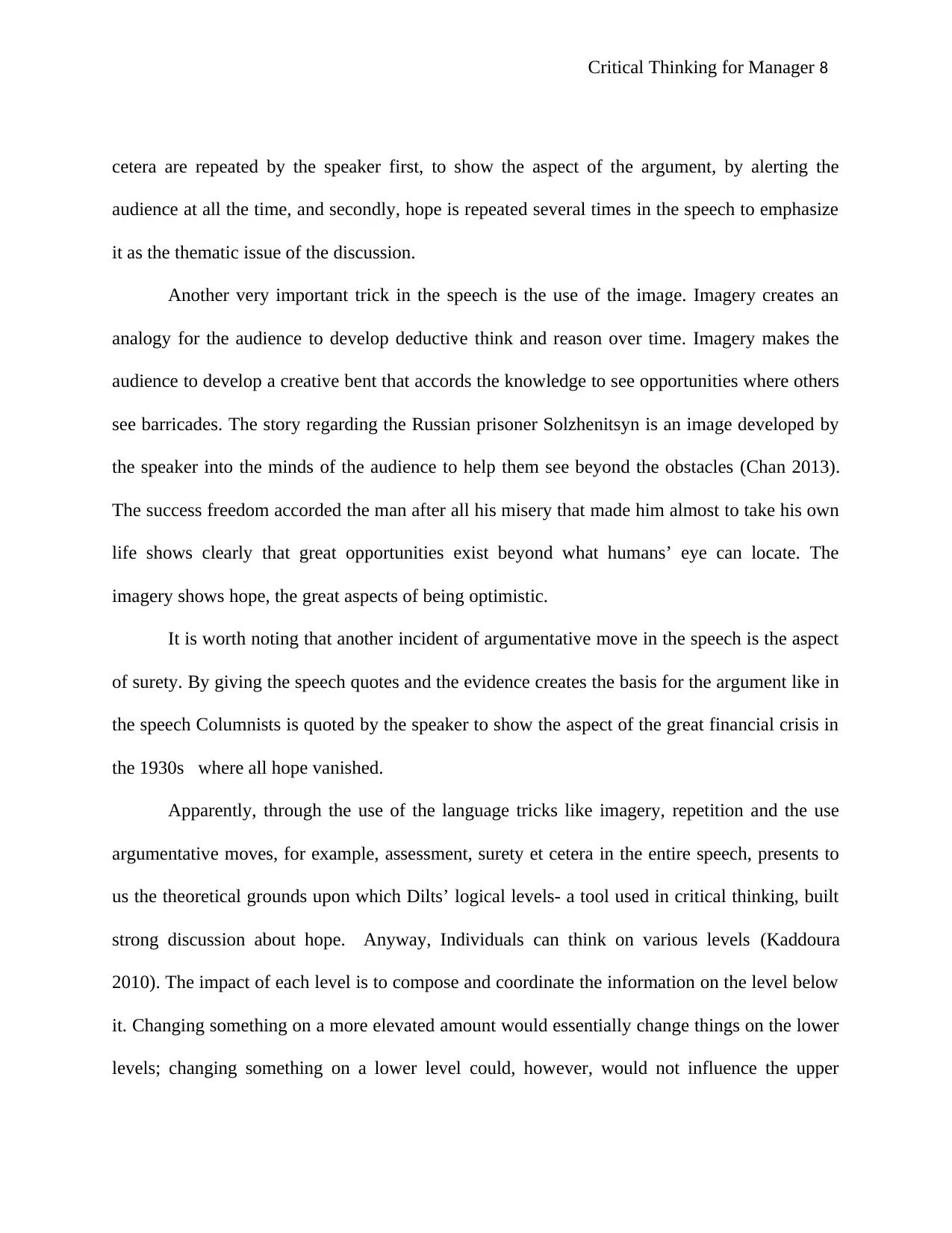
Critical Thinking for Manager 8
cetera are repeated by the speaker first, to show the aspect of the argument, by alerting the
audience at all the time, and secondly, hope is repeated several times in the speech to emphasize
it as the thematic issue of the discussion.
Another very important trick in the speech is the use of the image. Imagery creates an
analogy for the audience to develop deductive think and reason over time. Imagery makes the
audience to develop a creative bent that accords the knowledge to see opportunities where others
see barricades. The story regarding the Russian prisoner Solzhenitsyn is an image developed by
the speaker into the minds of the audience to help them see beyond the obstacles (Chan 2013).
The success freedom accorded the man after all his misery that made him almost to take his own
life shows clearly that great opportunities exist beyond what humans’ eye can locate. The
imagery shows hope, the great aspects of being optimistic.
It is worth noting that another incident of argumentative move in the speech is the aspect
of surety. By giving the speech quotes and the evidence creates the basis for the argument like in
the speech Columnists is quoted by the speaker to show the aspect of the great financial crisis in
the 1930s where all hope vanished.
Apparently, through the use of the language tricks like imagery, repetition and the use
argumentative moves, for example, assessment, surety et cetera in the entire speech, presents to
us the theoretical grounds upon which Dilts’ logical levels- a tool used in critical thinking, built
strong discussion about hope. Anyway, Individuals can think on various levels (Kaddoura
2010). The impact of each level is to compose and coordinate the information on the level below
it. Changing something on a more elevated amount would essentially change things on the lower
levels; changing something on a lower level could, however, would not influence the upper
cetera are repeated by the speaker first, to show the aspect of the argument, by alerting the
audience at all the time, and secondly, hope is repeated several times in the speech to emphasize
it as the thematic issue of the discussion.
Another very important trick in the speech is the use of the image. Imagery creates an
analogy for the audience to develop deductive think and reason over time. Imagery makes the
audience to develop a creative bent that accords the knowledge to see opportunities where others
see barricades. The story regarding the Russian prisoner Solzhenitsyn is an image developed by
the speaker into the minds of the audience to help them see beyond the obstacles (Chan 2013).
The success freedom accorded the man after all his misery that made him almost to take his own
life shows clearly that great opportunities exist beyond what humans’ eye can locate. The
imagery shows hope, the great aspects of being optimistic.
It is worth noting that another incident of argumentative move in the speech is the aspect
of surety. By giving the speech quotes and the evidence creates the basis for the argument like in
the speech Columnists is quoted by the speaker to show the aspect of the great financial crisis in
the 1930s where all hope vanished.
Apparently, through the use of the language tricks like imagery, repetition and the use
argumentative moves, for example, assessment, surety et cetera in the entire speech, presents to
us the theoretical grounds upon which Dilts’ logical levels- a tool used in critical thinking, built
strong discussion about hope. Anyway, Individuals can think on various levels (Kaddoura
2010). The impact of each level is to compose and coordinate the information on the level below
it. Changing something on a more elevated amount would essentially change things on the lower
levels; changing something on a lower level could, however, would not influence the upper
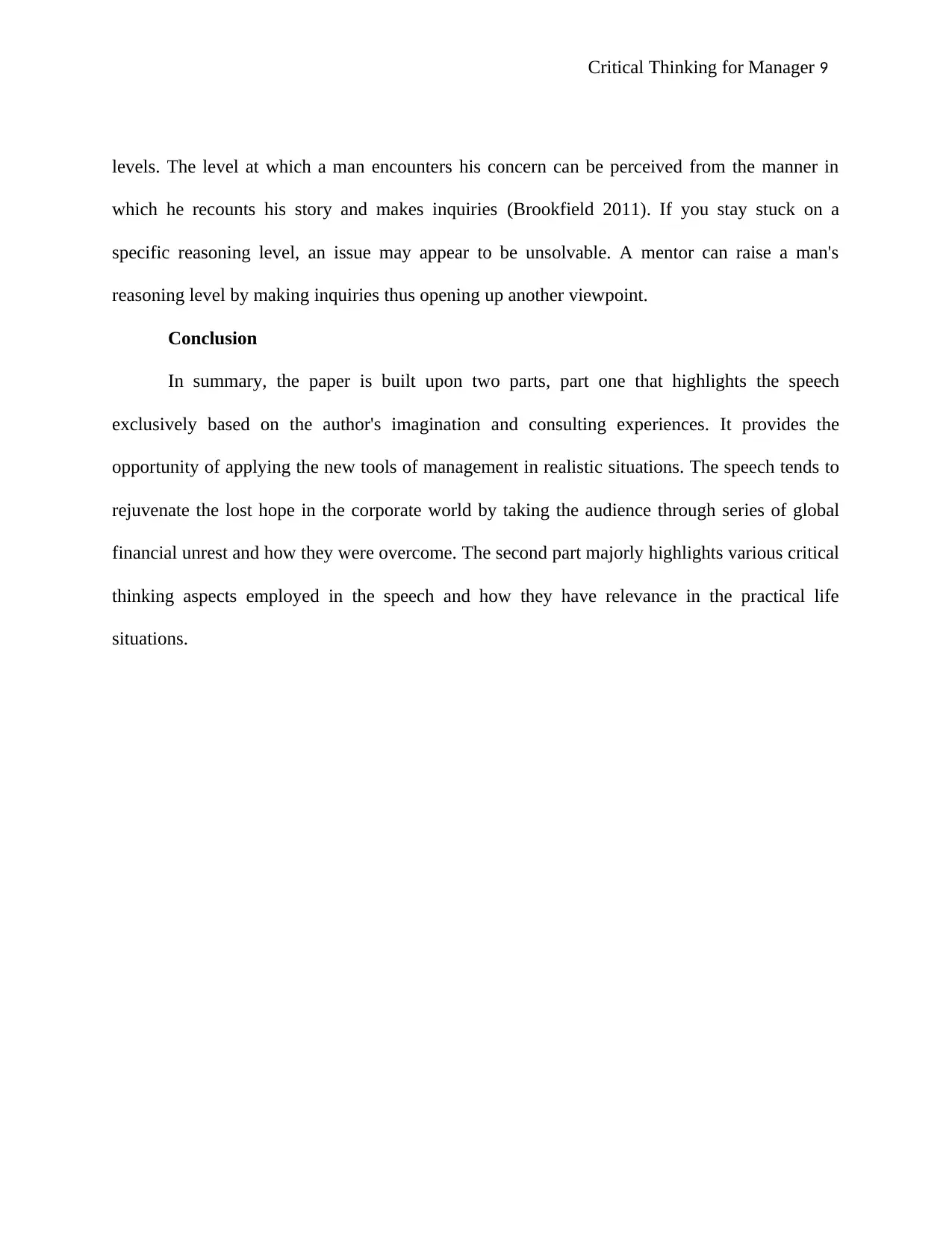
Critical Thinking for Manager 9
levels. The level at which a man encounters his concern can be perceived from the manner in
which he recounts his story and makes inquiries (Brookfield 2011). If you stay stuck on a
specific reasoning level, an issue may appear to be unsolvable. A mentor can raise a man's
reasoning level by making inquiries thus opening up another viewpoint.
Conclusion
In summary, the paper is built upon two parts, part one that highlights the speech
exclusively based on the author's imagination and consulting experiences. It provides the
opportunity of applying the new tools of management in realistic situations. The speech tends to
rejuvenate the lost hope in the corporate world by taking the audience through series of global
financial unrest and how they were overcome. The second part majorly highlights various critical
thinking aspects employed in the speech and how they have relevance in the practical life
situations.
levels. The level at which a man encounters his concern can be perceived from the manner in
which he recounts his story and makes inquiries (Brookfield 2011). If you stay stuck on a
specific reasoning level, an issue may appear to be unsolvable. A mentor can raise a man's
reasoning level by making inquiries thus opening up another viewpoint.
Conclusion
In summary, the paper is built upon two parts, part one that highlights the speech
exclusively based on the author's imagination and consulting experiences. It provides the
opportunity of applying the new tools of management in realistic situations. The speech tends to
rejuvenate the lost hope in the corporate world by taking the audience through series of global
financial unrest and how they were overcome. The second part majorly highlights various critical
thinking aspects employed in the speech and how they have relevance in the practical life
situations.
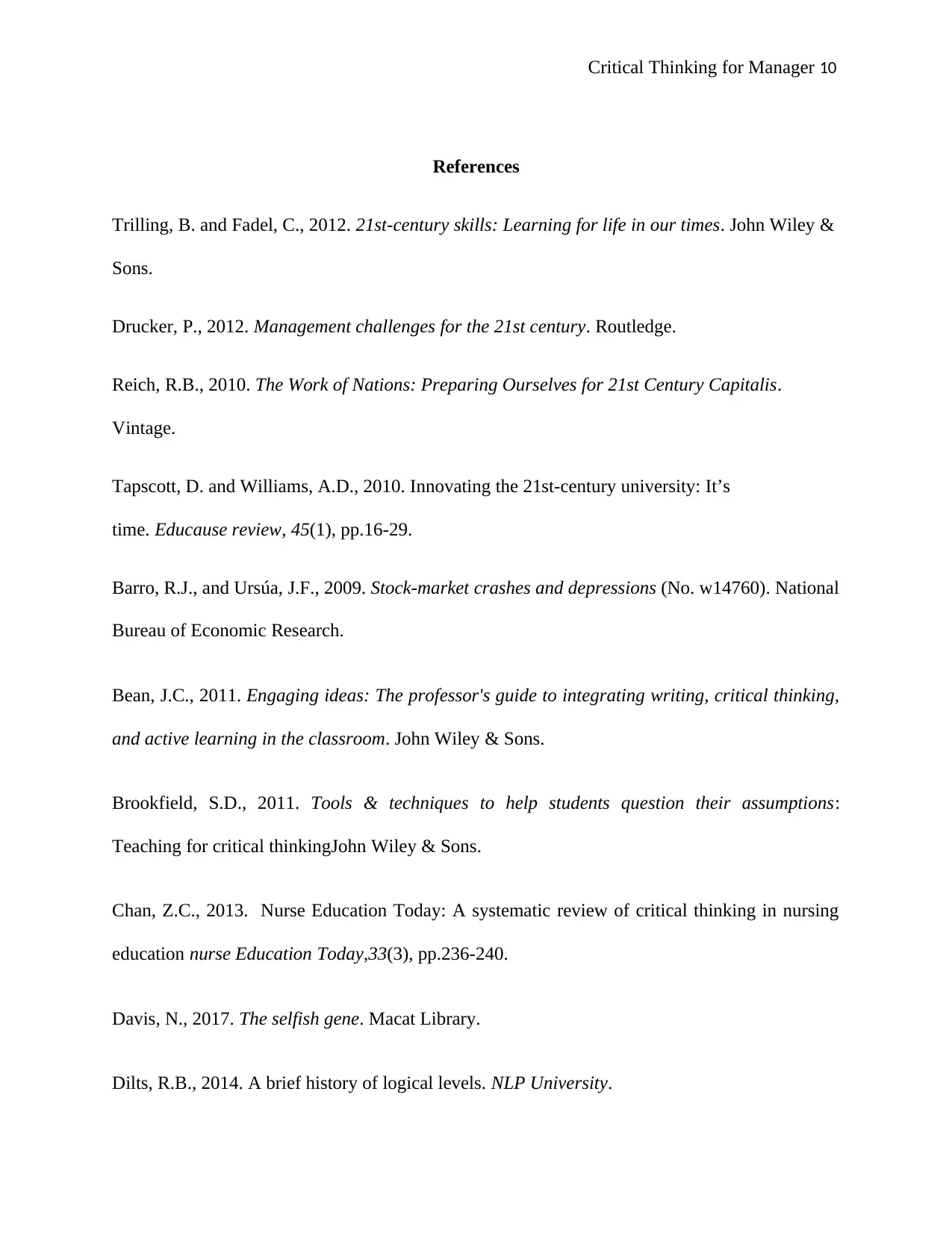
Critical Thinking for Manager 10
References
Trilling, B. and Fadel, C., 2012. 21st-century skills: Learning for life in our times. John Wiley &
Sons.
Drucker, P., 2012. Management challenges for the 21st century. Routledge.
Reich, R.B., 2010. The Work of Nations: Preparing Ourselves for 21st Century Capitalis.
Vintage.
Tapscott, D. and Williams, A.D., 2010. Innovating the 21st-century university: It’s
time. Educause review, 45(1), pp.16-29.
Barro, R.J., and Ursúa, J.F., 2009. Stock-market crashes and depressions (No. w14760). National
Bureau of Economic Research.
Bean, J.C., 2011. Engaging ideas: The professor's guide to integrating writing, critical thinking,
and active learning in the classroom. John Wiley & Sons.
Brookfield, S.D., 2011. Tools & techniques to help students question their assumptions:
Teaching for critical thinkingJohn Wiley & Sons.
Chan, Z.C., 2013. Nurse Education Today: A systematic review of critical thinking in nursing
education nurse Education Today,33(3), pp.236-240.
Davis, N., 2017. The selfish gene. Macat Library.
Dilts, R.B., 2014. A brief history of logical levels. NLP University.
References
Trilling, B. and Fadel, C., 2012. 21st-century skills: Learning for life in our times. John Wiley &
Sons.
Drucker, P., 2012. Management challenges for the 21st century. Routledge.
Reich, R.B., 2010. The Work of Nations: Preparing Ourselves for 21st Century Capitalis.
Vintage.
Tapscott, D. and Williams, A.D., 2010. Innovating the 21st-century university: It’s
time. Educause review, 45(1), pp.16-29.
Barro, R.J., and Ursúa, J.F., 2009. Stock-market crashes and depressions (No. w14760). National
Bureau of Economic Research.
Bean, J.C., 2011. Engaging ideas: The professor's guide to integrating writing, critical thinking,
and active learning in the classroom. John Wiley & Sons.
Brookfield, S.D., 2011. Tools & techniques to help students question their assumptions:
Teaching for critical thinkingJohn Wiley & Sons.
Chan, Z.C., 2013. Nurse Education Today: A systematic review of critical thinking in nursing
education nurse Education Today,33(3), pp.236-240.
Davis, N., 2017. The selfish gene. Macat Library.
Dilts, R.B., 2014. A brief history of logical levels. NLP University.
Secure Best Marks with AI Grader
Need help grading? Try our AI Grader for instant feedback on your assignments.
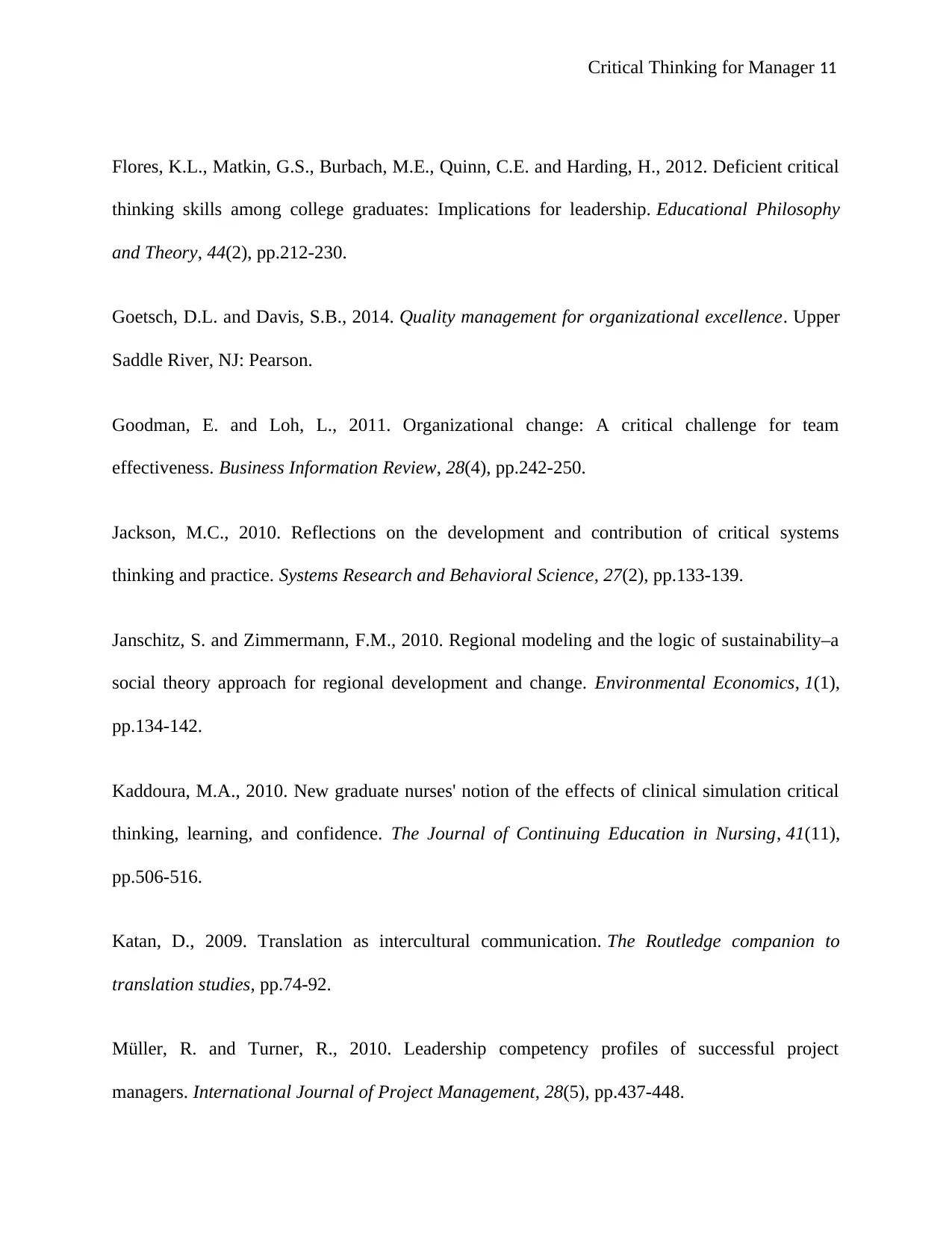
Critical Thinking for Manager 11
Flores, K.L., Matkin, G.S., Burbach, M.E., Quinn, C.E. and Harding, H., 2012. Deficient critical
thinking skills among college graduates: Implications for leadership. Educational Philosophy
and Theory, 44(2), pp.212-230.
Goetsch, D.L. and Davis, S.B., 2014. Quality management for organizational excellence. Upper
Saddle River, NJ: Pearson.
Goodman, E. and Loh, L., 2011. Organizational change: A critical challenge for team
effectiveness. Business Information Review, 28(4), pp.242-250.
Jackson, M.C., 2010. Reflections on the development and contribution of critical systems
thinking and practice. Systems Research and Behavioral Science, 27(2), pp.133-139.
Janschitz, S. and Zimmermann, F.M., 2010. Regional modeling and the logic of sustainability–a
social theory approach for regional development and change. Environmental Economics, 1(1),
pp.134-142.
Kaddoura, M.A., 2010. New graduate nurses' notion of the effects of clinical simulation critical
thinking, learning, and confidence. The Journal of Continuing Education in Nursing, 41(11),
pp.506-516.
Katan, D., 2009. Translation as intercultural communication. The Routledge companion to
translation studies, pp.74-92.
Müller, R. and Turner, R., 2010. Leadership competency profiles of successful project
managers. International Journal of Project Management, 28(5), pp.437-448.
Flores, K.L., Matkin, G.S., Burbach, M.E., Quinn, C.E. and Harding, H., 2012. Deficient critical
thinking skills among college graduates: Implications for leadership. Educational Philosophy
and Theory, 44(2), pp.212-230.
Goetsch, D.L. and Davis, S.B., 2014. Quality management for organizational excellence. Upper
Saddle River, NJ: Pearson.
Goodman, E. and Loh, L., 2011. Organizational change: A critical challenge for team
effectiveness. Business Information Review, 28(4), pp.242-250.
Jackson, M.C., 2010. Reflections on the development and contribution of critical systems
thinking and practice. Systems Research and Behavioral Science, 27(2), pp.133-139.
Janschitz, S. and Zimmermann, F.M., 2010. Regional modeling and the logic of sustainability–a
social theory approach for regional development and change. Environmental Economics, 1(1),
pp.134-142.
Kaddoura, M.A., 2010. New graduate nurses' notion of the effects of clinical simulation critical
thinking, learning, and confidence. The Journal of Continuing Education in Nursing, 41(11),
pp.506-516.
Katan, D., 2009. Translation as intercultural communication. The Routledge companion to
translation studies, pp.74-92.
Müller, R. and Turner, R., 2010. Leadership competency profiles of successful project
managers. International Journal of Project Management, 28(5), pp.437-448.
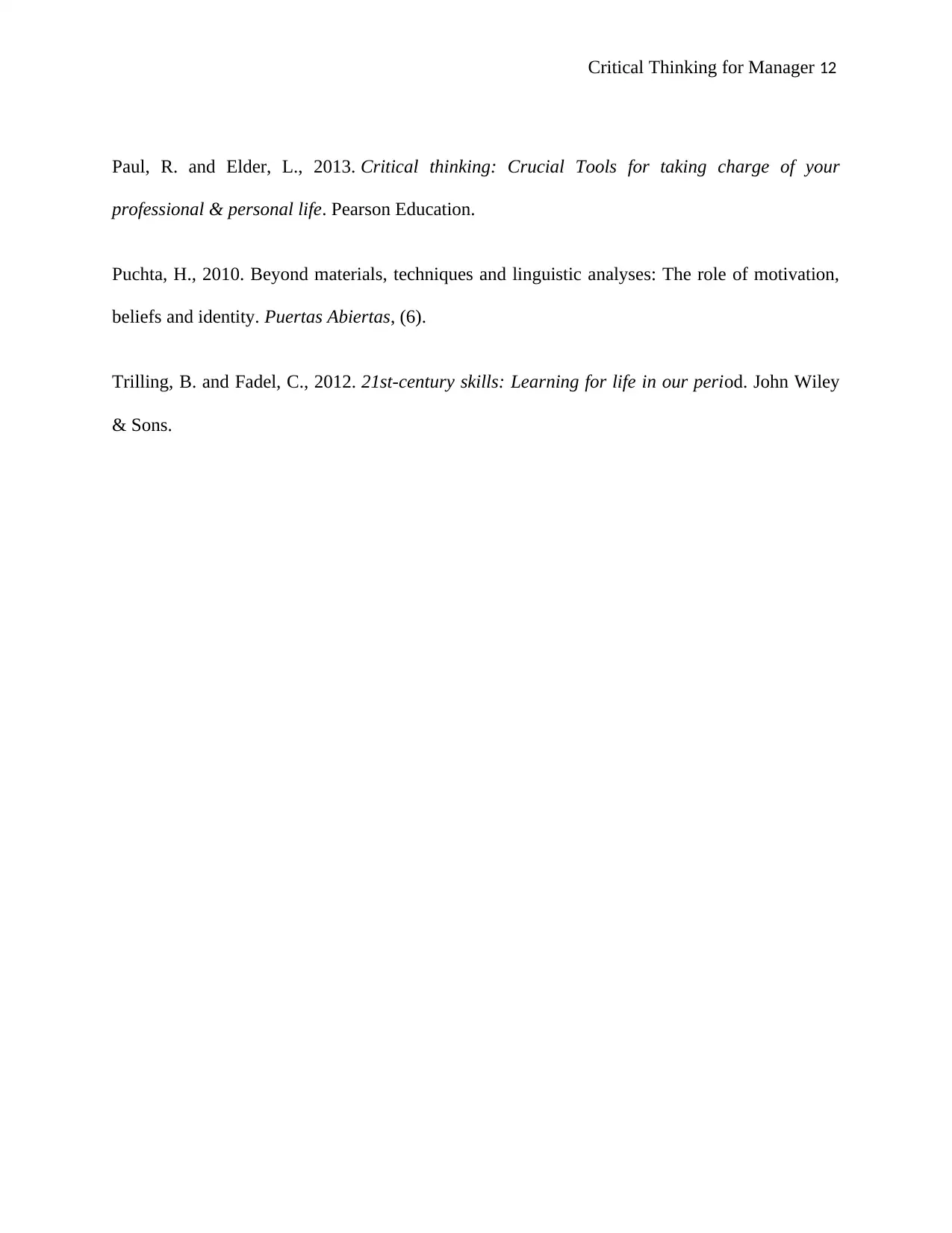
Critical Thinking for Manager 12
Paul, R. and Elder, L., 2013. Critical thinking: Crucial Tools for taking charge of your
professional & personal life. Pearson Education.
Puchta, H., 2010. Beyond materials, techniques and linguistic analyses: The role of motivation,
beliefs and identity. Puertas Abiertas, (6).
Trilling, B. and Fadel, C., 2012. 21st-century skills: Learning for life in our period. John Wiley
& Sons.
Paul, R. and Elder, L., 2013. Critical thinking: Crucial Tools for taking charge of your
professional & personal life. Pearson Education.
Puchta, H., 2010. Beyond materials, techniques and linguistic analyses: The role of motivation,
beliefs and identity. Puertas Abiertas, (6).
Trilling, B. and Fadel, C., 2012. 21st-century skills: Learning for life in our period. John Wiley
& Sons.
1 out of 12
Your All-in-One AI-Powered Toolkit for Academic Success.
+13062052269
info@desklib.com
Available 24*7 on WhatsApp / Email
![[object Object]](/_next/static/media/star-bottom.7253800d.svg)
Unlock your academic potential
© 2024 | Zucol Services PVT LTD | All rights reserved.